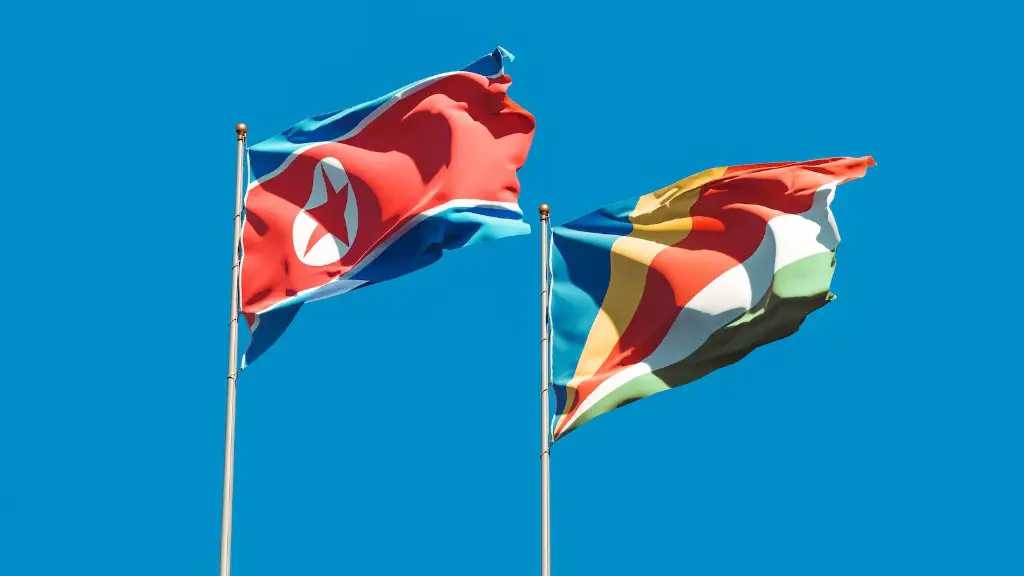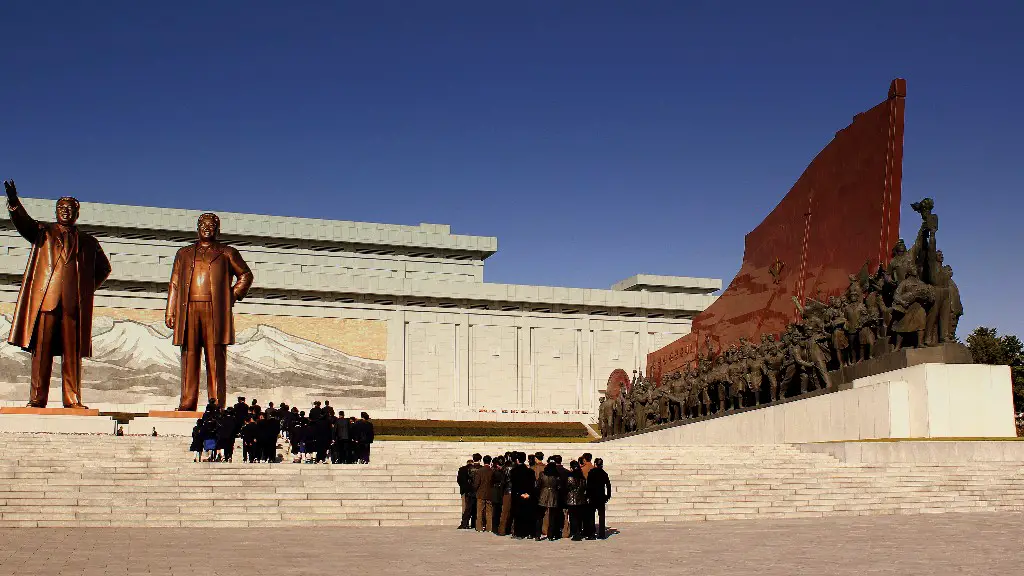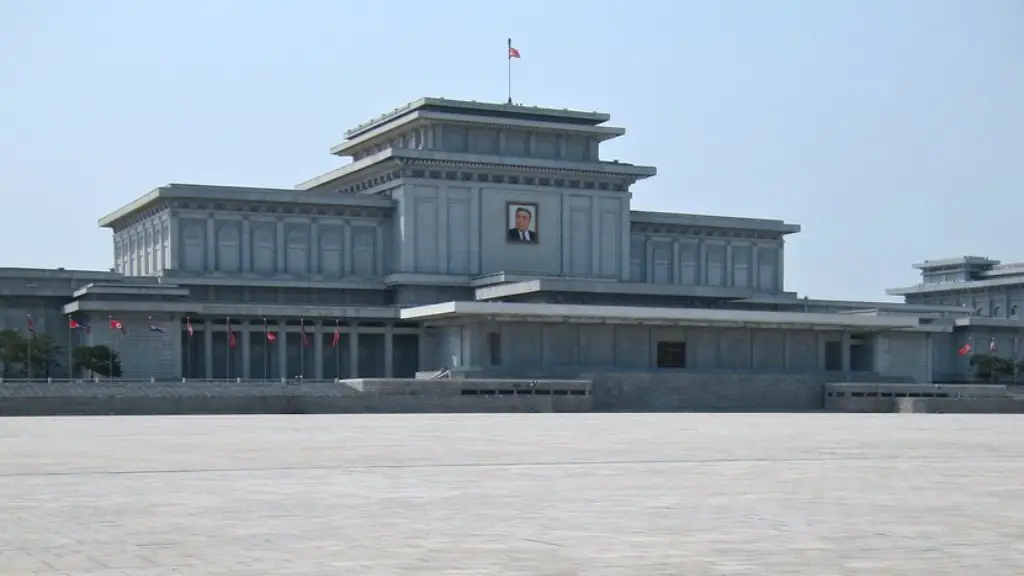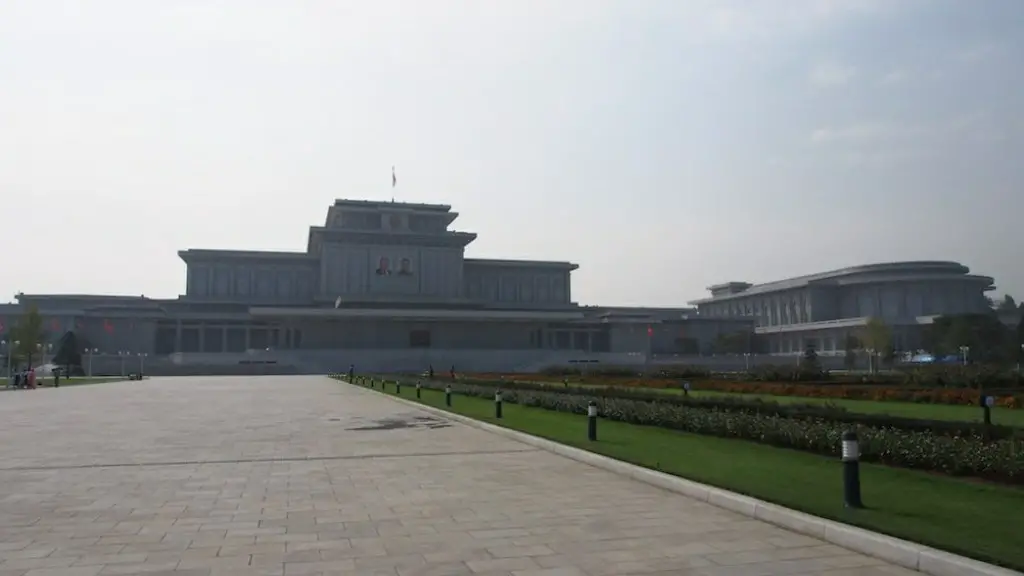North Korea’s peculiar marching style has become increasingly well-known in recent years. The march of the North Korean military is composed of a combination of chanting slogans, singing the national anthem, and synchronized foot movements designed to intimidate its adversaries. There are several theories regarding the origin of this march; some believe it is based on Soviet military traditions, while others think it may be a modified version of traditional Korean drumming. Regardless of its origin, its purpose is clear: to enhance the presentation of military power and to remind its adversaries of the ferocity of its fighting forces.
One of the most recognizable aspects of the North Korean march is its perfectly synchronized rhythm. Working together to perfectly coordinate their steps, thousands of North Korean soldiers can execute complex maneuvers without fail. This emphasis on synchronized marching is an important part of the North Korean military’s psychological warfare. By appearing to be an unstoppable force, the march can enervate the enemy. As North Korean military expert Bruce Bechtol puts it, “The idea is to create a feeling of extreme intimidation that paralyzes the will to fight.”
North Korea’s military is also known for its incredibly loud chants and singing. Soldiers chant slogans such as “long live our leader Kim Jong-un” and “we’ll defend our homeland to death” as they march in perfect unison. The din created by these chants is further amplified by the sound of the North Korean national anthem, which is played by a military band. As a result of these combined elements, the North Korean march is an intensifying experience for any who witness it.
However, the North Korean march is more than just a show of force. It is also a crucial part of the North Korean system of discipline and indoctrination. As North Koreans are indoctrinated from a young age with the values of their leaders and the country, it is necessary to ensure that they keep in line with these values. As such, regular military training is necessary in order to maintain the status quo and ensure that all citizens remain loyal to Kim Jong-un and his regime. As Dr. John Park of Harvard’s Kennedy School of Government suggests, “The march is intended to help maintain control and order by instilling a sense of collective discipline.”
Change Over Time
Though the North Korean march has remained essentially unchanged for the past few decades, it has evolved over time to take on some new characteristics. In particular, the chants have become increasingly militaristic, with soldiers increasingly using slogans such as “Destroy the enemy!” and “Annihilate our enemies!” These more militant chants are a reflection of North Korea’s recent political and military instability as the country continues to face pressure from both its regional neighbors and the United States.
North Korea’s march has also been known to include some more unusual elements. For example, soldiers have sometimes been observed performing synchronized diff movements reminiscent of traditional Korean martial arts. These motions are thought to be symbolic of the strength and unity of the North Korean people.
Overall, the North Korean march is an important and recognizable part of the country’s military strategy and culture. Despite the peculiarities of its execution and the chilling implications of its message, the march has no doubt been effective at intimidating and unifying its citizens.
Purpose of the March
It is important to understand that the march is a deliberate display of authority. By appearing to be a unified and powerful force, the North Korean military hopes to intimidate its adversaries and ensure control at home. North Korean military expert Dr. Andrew O’Neil believes that the march serves both these functions; it is intended to demonstrate the power and strength of the military both externally and internally.A display of unity and absolute obedience is an essential element of the march and its effectiveness. As O’Neil explains, the march “is used to demonstrate that everyone is on the same page and know what is expected of them.”
In turn, the march serves as a reminder to North Korean citizens that the military both guides and protects them. As a result, it can be seen as an important element of national identity and pride. The march encourages national unity and loyalty to the state, as citizens view themselves as part of a larger, unstoppable force.
Military Culture
The ferocity of the North Korean march is also an important element of the country’s military culture. North Korea’s military is renowned for its extreme tenacity and discipline, and the march is the public manifestation of these values. The march is intended to show the strength and solidarity of the North Korean people and to illustrate their willingness to fight for their leaders and their country.
The march’s strict rhythm and unwavering discipline also reflect the challenge and strength of the military system as a whole. The North Korean march and military is known for its uncompromising adherence to the orders of its leaders, and the march serves as a demonstration of this reverence.
Above all, North Korea’s unusual marching style serves as a reminder of the country’s unique history and culture. It is a physical demonstration of the strength and ferocity of the North Korean people, and the fear and intimidation it evokes have been used to maintain order and loyalty to the state.
Relations to Other Countries
The march is also closely related to North Korea’s relationship to other countries. Historically, the march has been used as a way to demonstrate the strength of North Korea’s military, especially when gatherings of foreign dignitaries are present. This display is often combined with other presentations of military might, such as parades and demonstrations of military technology.
Ultimately, North Korea’s march is a unique symbol of the country’s strength and determination. It is a vivid reminder of the country’s military prowess and of its dedication to preserving the Kim Jong-un regime. While the march may be seen as an intimidating display of power, it is also an expression of the North Korean people’s commitment to their country and to their leader.
Implications of the March
North Korea’s march is widely known around the world as a symbol of the country’s aggressive stance and oppressive regime. A relentless show of power and military might, the march serves as a stark warning to potential adversaries. The march and its implications for the country have prompted many to call for increased diplomatic solutions to the country’s ongoing situation.
The march also raises important questions about the North Korean state and its authoritarian rule. As the march can be seen as a tool used to maintain control and order within the country, it can be seen as an extension of the state’s oppressive and militaristic tendencies. This raises the difficult question of whether or not the Kim Jong-un regime can indeed be toppled without the use of force.
Finally, the march raises questions about the long-term implications of North Korea’s military might. As its military arsenal continues to grow and its technological capabilities become increasingly sophisticated, the implications of the country’s military power should not be overlooked. It is clear that North Korea’s march is more than just a show of force; it is also a call to arms.
Innovations of the March
Despite being rooted in tradition, the North Korean march is not a static phenomenon. Recent years have seen the march adapt to new technologies and trends, particularly with the introduction of North Korea’s unmanned aerial vehicles. While the march remains the cornerstone of North Korea’s military message, it has begun to incorporate UAVs in order to enhance its visual effects and to continue to threaten its adversaries.
The march has also begun to incorporate more high-tech military equipment such as tanks and high tech weaponry. This serves to enhance the intimidating effect of the march and to show North Korea’s technical capabilities. Furthermore, North Korea has also begun to simulate battlefield conditions during the march. This serves to both prepare the soldiers for battle and to demonstrate the strength of their training and discipline.
The North Korean march is thus evolving to fit with the demands of the 21st century. By incorporating new technology and innovation, the march has become an even more impressive display of military might.
International Reception
The North Korean march has naturally been met with a degree of skepticism and trepidation in many countries. Some see the march as a symbol of North Korea’s tyrannical and oppressive regime while others view it as an example of North Korea’s determination and strength. Regardless, the march is unmistakably a symbol of North Korea’s powerful army and its willingness to defend its homeland.
Still, the march is of great interest to foreign onlookers. The sight of thousands of soldiers marching in step is a remarkable spectacle, and the North Korean march has sparked curiosity from many foreign militaries who are eager to learn from the North Koreans’ impressive display of coordination and discipline.
Regardless of its implication, the North Korean march is undeniably intriguing. With its unique history and its continued innovation, the march is a fascinating reminder of North Korea’s military power and its dedication to maintaining control over its citizens.





